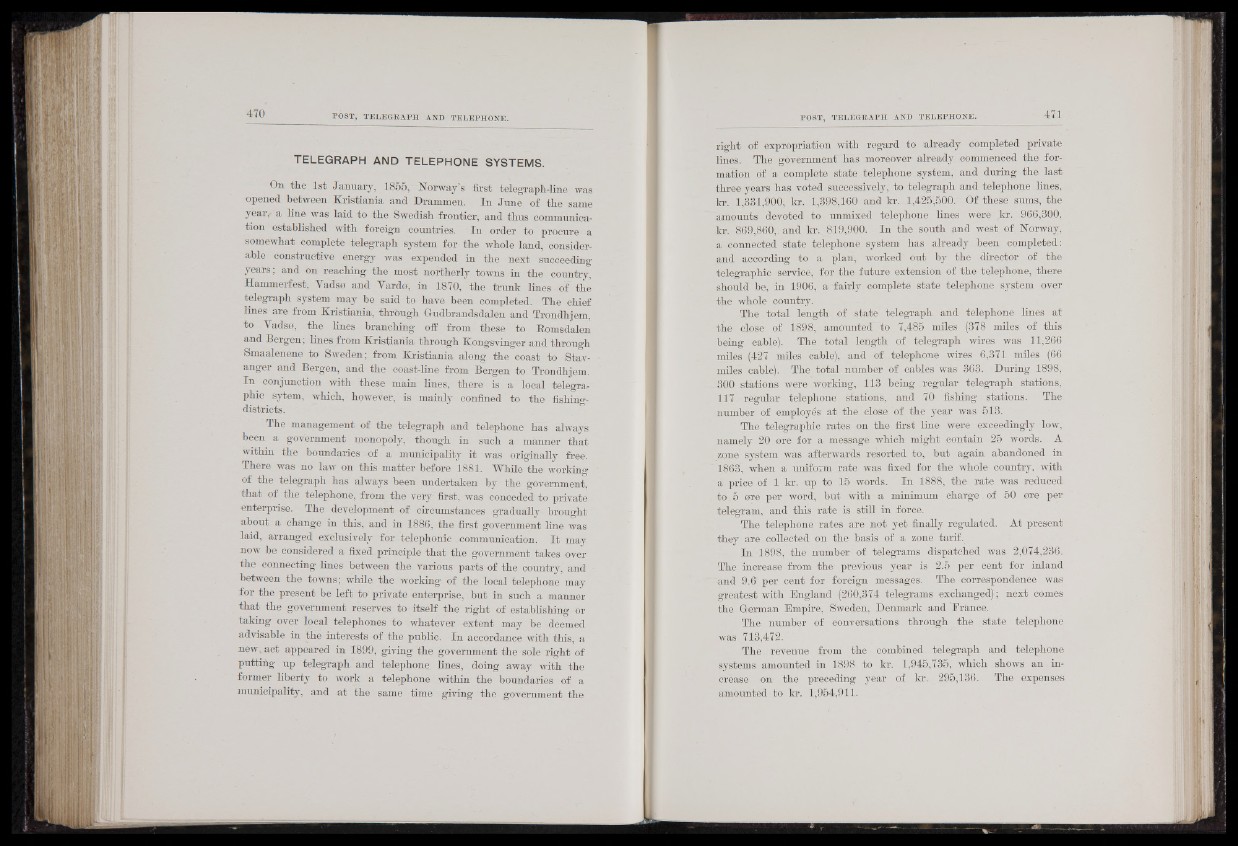
TELEGRAPH AND TELEPHONE SYSTEMS.
On the 1st January, 1855, Norway’s first telegraph-line was
opened between Kristiania and Drammen. In Jnne of the same
yeajy a line was laid to the Swedish frontier, and thus communication
established with foreign countries. In order to procure a
somewhat complete telegraph system for the whole land, considerable
constructive energy was expended in the next succeeding
years, and on reaching the most northerly towns in the country,
Hammerfest, Vadso and Yardo, in 1870, the trunk lines -of thè
telegraph system may be said to have been completed. The chief
lines are from Kristiania, through Gudbrandsdalen and Trondhjem,
to Vadso, the lines branching off from these to Romsdalen
and Bergen ; lines from Kristiania through Kongsvinger and through
Smaalenene to Sweden; from Kristiania along the coast to Stavanger
and Bergen, and the coast-line from Bergen to Trondhjem.
In^ conjunction with these main lines, there is a local telegraphic
sytem, which, however, is mainly confined ' to the fishing-
districts.
The management of the telegraph and telephone has always
been a government monopoly, though in such a manntr that
within the boundaries of a municipality it was originally free.
There was no law on this matter before 1881. YV ! ri 1 e the working
of the telegraph has always been undertaken by the government,
that of the telephone, from the very first, was conceded to private
enterprise. The development of circumstances gradually brought
about a change in this, and in 1886, the first government line was
laid, arranged exclusively for telephonic -communication. I t may
now be considered a fixed, principle that the government takes over
the connecting lines between the various parts of the country, and
between the towns; while the working of the local telephone may
for the present be left to private enterprise, but in such a manner
th a t the government reserves to itself the right of establishing or
taking over local telephones to whatever extent may be deemed
advisable in the interests of the public. In accordance with this, a
new, act appeared in 1899, giving the government the sole right of
putting up telegraph and telephone lines, doing away with the
former liberty to work a telephone within the boundaries of a
municipality, and at the same time giving the government the
right of expropriation with regard to already completed private
lines. The government has moreover already commenced the formation
of a complete state telephone system, and during the last
three years has voted successively, to telegraph and telephone lines,
kr. 1,331,900, kr. 1,398,160 and kr. 1,425,500. Of these sums, the
amounts devoted to unmixed telephone lines were kr. 966,300,
kr. 869,860,. and kr. 819,900. In the south and west of Norway,
a connected state telephone system has already been completed:
and according to a plan, worked' out by the director of the
telegraphic service, for the future extension of the telephone, there
should be, in 1906, a fairly complète state telephone system over
the whole country.
The total length of state telegraph and telephone lines at
the close of 1898, amounted to 7,485 miles (378 miles of this
being cable). The total length of telegraph wires was 11,266
miles (427 miles cable), and of telephone wires 6,371 miles (66
miles cable). The total number of cables was 363. During 1898,
300 stations were working, 113 being regular telegraph stations,
117 regular telephone stations, and 70 fishing stations. The
number of employes at the close of the year was 513.
The telegraphic rates on the first line were exceedingly low,
namely 20 are for a message which might contain 25 words. A
zone system was afterwards resorted to, but again abandoned in
1863, when a uniform rate was fixed for the whole country, with
à price of 1 kr. up to 15 words. In 1888, the rate was reduced
to 5 ere per word, but with a minimum charge of 50 ere per
telegram, and this rate is still in force.
The telephone rates are not yet finally regulated. At present
they are collected on the basis of a zone tarif.
In 1898, the number of telegrams dispatched was 2,074,236.
The increase from the previous year is 2.5 per cent for inland
and 9.6 per cent for foreign messages. The correspondence was
greatest with England (260,374 telegrams exchanged) ; next comes
the German Empire, Sweden, Denmark and France.
The number of conversations through the state telephone
was 713,472.
The revenue from the combined telegraph and telephone
systems amounted in 1898 to kr. 1,945,735, which shows an increase
on the preceding year of kr. 295,136. The expenses
amounted to kr. 1,954,911.